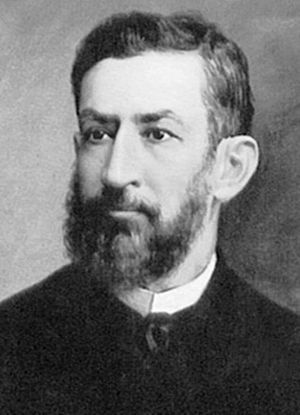Juan León Mera facts for kids
Quick facts for kids
Juan León Mera
|
|
|---|---|
 |
|
| Born | Juan León Mera Martínez 28 June 1832 Ambato, Ecuador |
| Died | December 13, 1894 (aged 62) Ambato, Ecuador |
| Occupation |
|
| Language | Spanish |
| Nationality | Ecuadorian |
| Notable works | Cumandá (1879) a novel, "Salve, Oh Patria" (1865) the National Anthem of Ecuador |
Juan León Mera Martínez (born June 28, 1832 – died December 13, 1894) was an important person from Ecuador. He was a writer, a novelist, a politician, and even a painter.
His most famous works are the National Anthem of Ecuador and his novel Cumandá, which was published in 1879. He also worked for President Gabriel García Moreno as a government official.
Contents
About Juan León Mera
Juan León Mera was born in Ambato on June 28, 1832. He passed away in the same city on December 13, 1894. His father was a businessman. His mother, Josefa Martínez Vásconez, raised him by herself.
His childhood was not easy. He lived on a country property called “Los Molinos” in Ambato. To help the family, his grandmother rented out the property. Juan León Mera was taught at home by his great-uncle and his uncle, Nicolás Martínez, who was a doctor.
When he was twenty years old, he went to Quito. There, he studied painting with a famous artist named Antonio Salas. He learned to paint with oil and watercolors. When he was 33, he worked with Antonio Neumane to create the words for the National Anthem of Ecuador, called "Salve, Oh Patria."
Juan León Mera's son, José Trajano Mera (1862 – 1919), also became a poet, a writer for plays, and a diplomat.
His Writing Career
In 1854, Juan León Mera published his first poems. They appeared in a newspaper called La Democracia. He got help from another writer, Miguel Riofrío.
He started the Ecuadorian Academy of Language in 1874. He also became a member of the Real Academia Española, which is a very important group for the Spanish language.
Juan León Mera is seen as one of the first important writers in Ecuadorian literature. His most famous novel is Cumandá. This book shows the complex mix of different groups of people in Ecuador after it became independent. The novel was first published in Quito in 1879. Later, it was published in Madrid in 1891.
Later, in the 20th century, three Ecuadorian play writers used Cumandá to create operas. These writers were Luis H. Salgado (1903–1977), Pedro Pablo Traversari Salazar (1874–1956), and Sixto María Durán Cárdenas (1875–1947).
His Political Work
Besides being a writer and painter, Juan León Mera was also a politician. He was a conservative, meaning he believed in traditional ways of governing. He was a supporter of President Gabriel García Moreno.
He held many important government jobs:
- He was the governor of Cotopaxi.
- He was the Secretary of the Council of State.
- He served as a Senator.
- In 1886, he was the President of the Senate and the National Congress.
Today, you can visit his old home in Ambato. It is now a museum called "La quinta de Juan León Mera." It shows many of his personal belongings.
Main Works by Juan León Mera
| Year Published | Name of Work |
|---|---|
| 1857 | Fantasías |
| 1857 | Afectos íntimos |
| 1858 | Melodías indígenas |
| 1858 | Poesías |
| 1861 | La virgen del sol |
| 1865 | Himno Nacional del Ecuador |
| 1868 | Ojeada histórico-crítica sobre la poesía ecuatoriana |
| 1872 | Los novios de una aldea ecuatoriana |
| 1875 | Mazorra |
| 1879 | Cumandá o un drama entre salvajes |
| 1883 | Los últimos momentos de Bolívar |
| 1884 | La dictadura y la restauración de la República del Ecuador |
| 1887 | Lira ecuatoriana |
| 1889 | Entre dos tías y un tío |
| 1890 | Porqué soy cristiano |
| 1892 | Antología ecuatoriana: cantares del pueblo |
| 1903 | Tijeretazos y plumadas |
| 1904 | García Moreno |
| 1909 | Novelitas ecuatorianas |
Operas Based on Cumandá
Juan León Mera's novel Cumandá has been turned into three different operas:
- Cumandá, an opera by Luis H. Salgado
- Cumandá, an opera by Sixto María Durán Cárdenas
- Cumandá o la virgen de las selvas, an opera by Pedro Pablo Traversari Salazar
See also
 In Spanish: Juan León Mera para niños
In Spanish: Juan León Mera para niños

